Law Assignment: Contract, Mistake, Negligence and Vicarious Liability
VerifiedAdded on 2020/02/18
|10
|2003
|137
Homework Assignment
AI Summary
This law assignment provides a comprehensive analysis of contract law, addressing the essential elements of a valid contract, including offer, acceptance, consideration, and intention to create legal relations. It examines the impact of mistakes, specifically unilateral mistakes, on contract validity and explores available remedies. The assignment then delves into the tort of negligence, outlining the elements required to establish negligence and applying them to a case scenario. It further investigates vicarious liability, determining an employer's responsibility for the actions of their employees. Finally, the assignment addresses the types of damages available to a plaintiff in a negligence case, distinguishing between special and general damages, and their applicability to the given scenario. The assignment uses case law to support its findings, demonstrating a strong understanding of legal principles and their practical application. The assignment includes a bibliography of sources used for research.
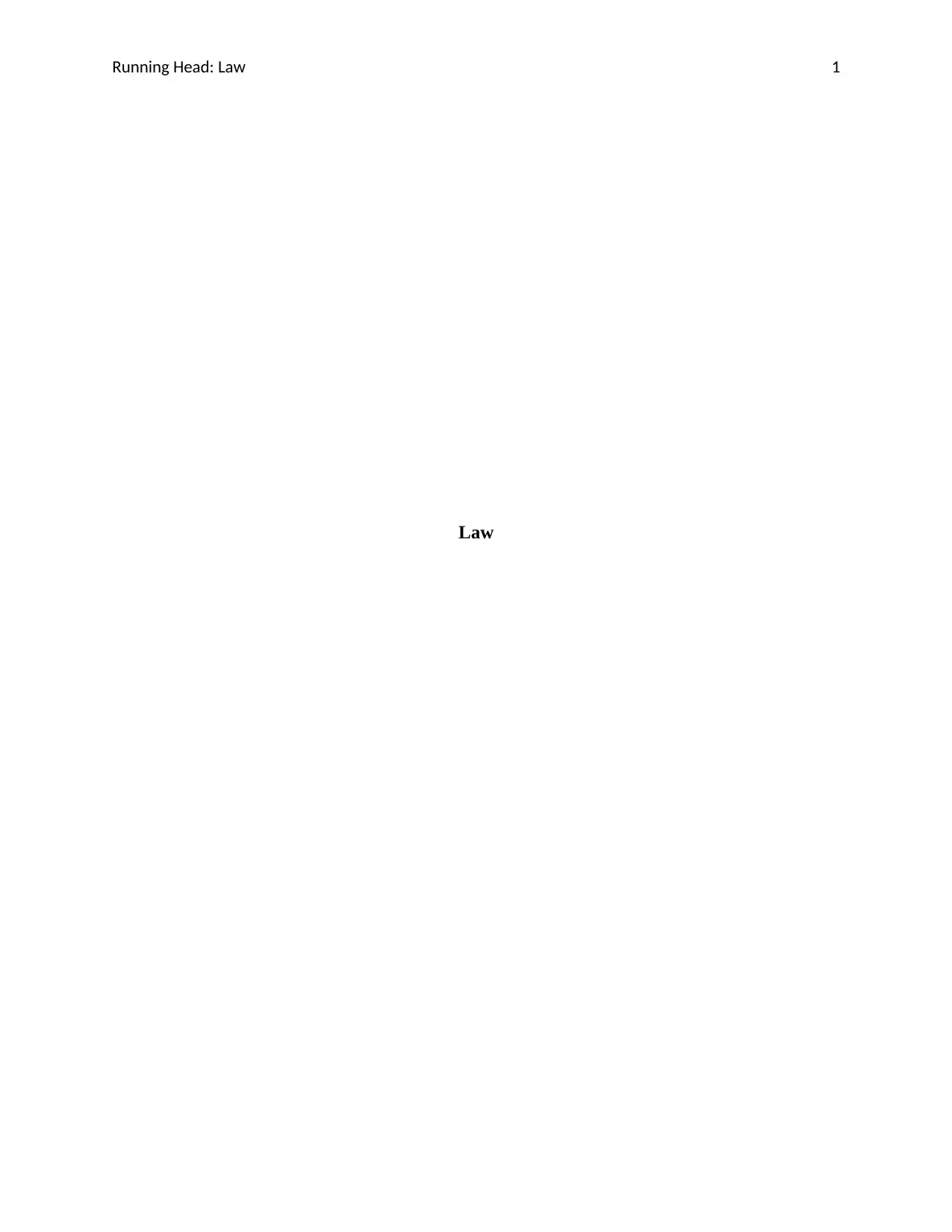
Running Head: Law 1
Law
Law
Paraphrase This Document
Need a fresh take? Get an instant paraphrase of this document with our AI Paraphraser
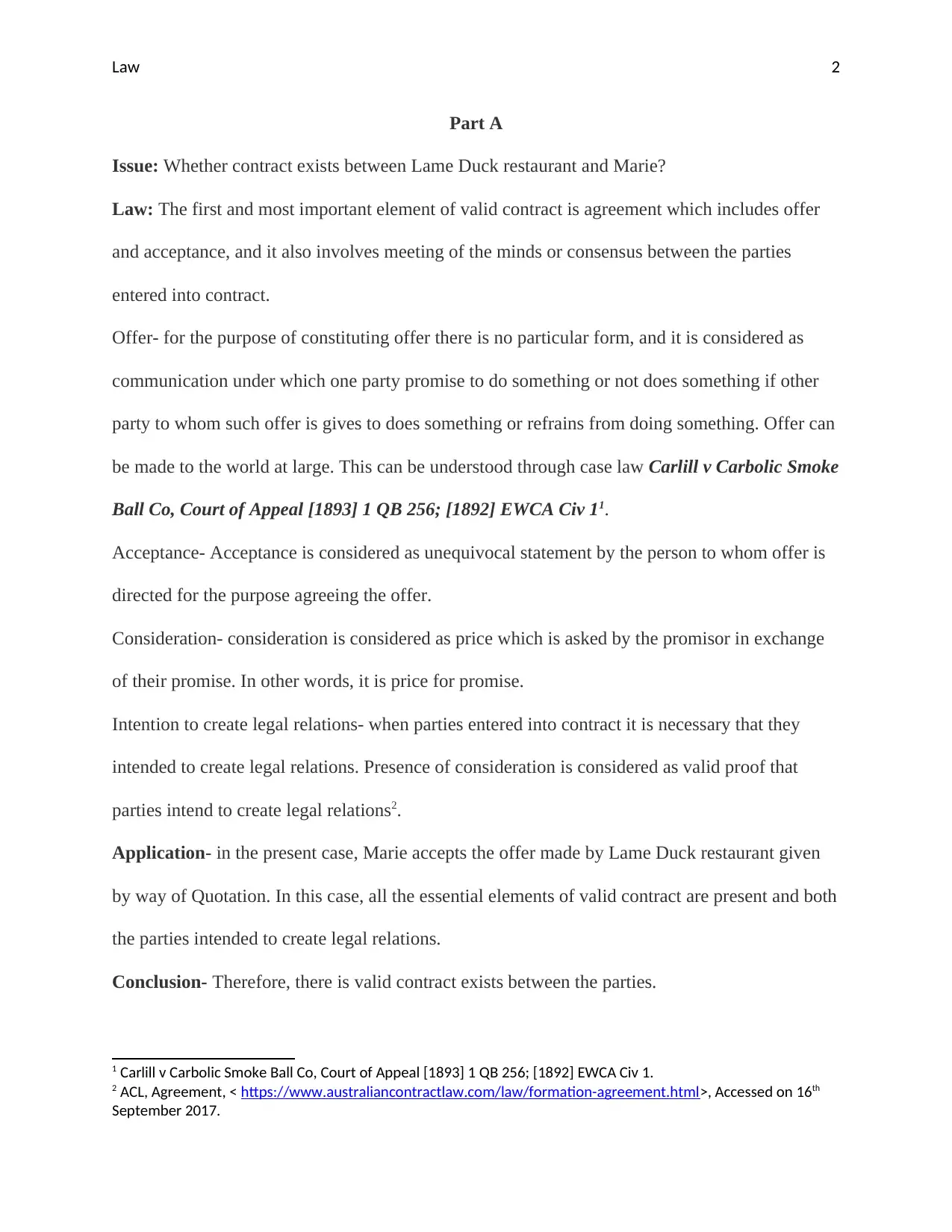
Law 2
Part A
Issue: Whether contract exists between Lame Duck restaurant and Marie?
Law: The first and most important element of valid contract is agreement which includes offer
and acceptance, and it also involves meeting of the minds or consensus between the parties
entered into contract.
Offer- for the purpose of constituting offer there is no particular form, and it is considered as
communication under which one party promise to do something or not does something if other
party to whom such offer is gives to does something or refrains from doing something. Offer can
be made to the world at large. This can be understood through case law Carlill v Carbolic Smoke
Ball Co, Court of Appeal [1893] 1 QB 256; [1892] EWCA Civ 11.
Acceptance- Acceptance is considered as unequivocal statement by the person to whom offer is
directed for the purpose agreeing the offer.
Consideration- consideration is considered as price which is asked by the promisor in exchange
of their promise. In other words, it is price for promise.
Intention to create legal relations- when parties entered into contract it is necessary that they
intended to create legal relations. Presence of consideration is considered as valid proof that
parties intend to create legal relations2.
Application- in the present case, Marie accepts the offer made by Lame Duck restaurant given
by way of Quotation. In this case, all the essential elements of valid contract are present and both
the parties intended to create legal relations.
Conclusion- Therefore, there is valid contract exists between the parties.
1 Carlill v Carbolic Smoke Ball Co, Court of Appeal [1893] 1 QB 256; [1892] EWCA Civ 1.
2 ACL, Agreement, < https://www.australiancontractlaw.com/law/formation-agreement.html>, Accessed on 16th
September 2017.
Part A
Issue: Whether contract exists between Lame Duck restaurant and Marie?
Law: The first and most important element of valid contract is agreement which includes offer
and acceptance, and it also involves meeting of the minds or consensus between the parties
entered into contract.
Offer- for the purpose of constituting offer there is no particular form, and it is considered as
communication under which one party promise to do something or not does something if other
party to whom such offer is gives to does something or refrains from doing something. Offer can
be made to the world at large. This can be understood through case law Carlill v Carbolic Smoke
Ball Co, Court of Appeal [1893] 1 QB 256; [1892] EWCA Civ 11.
Acceptance- Acceptance is considered as unequivocal statement by the person to whom offer is
directed for the purpose agreeing the offer.
Consideration- consideration is considered as price which is asked by the promisor in exchange
of their promise. In other words, it is price for promise.
Intention to create legal relations- when parties entered into contract it is necessary that they
intended to create legal relations. Presence of consideration is considered as valid proof that
parties intend to create legal relations2.
Application- in the present case, Marie accepts the offer made by Lame Duck restaurant given
by way of Quotation. In this case, all the essential elements of valid contract are present and both
the parties intended to create legal relations.
Conclusion- Therefore, there is valid contract exists between the parties.
1 Carlill v Carbolic Smoke Ball Co, Court of Appeal [1893] 1 QB 256; [1892] EWCA Civ 1.
2 ACL, Agreement, < https://www.australiancontractlaw.com/law/formation-agreement.html>, Accessed on 16th
September 2017.
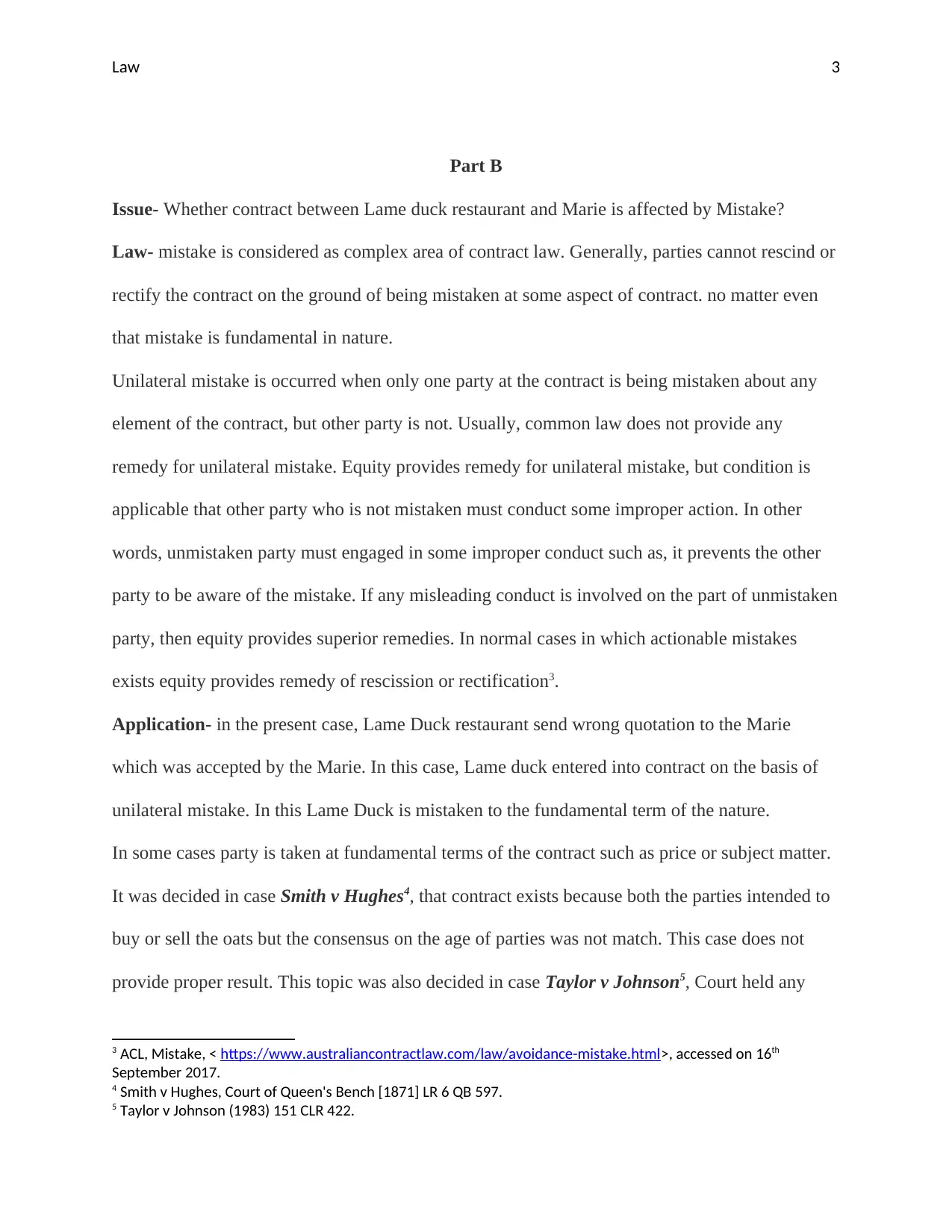
Law 3
Part B
Issue- Whether contract between Lame duck restaurant and Marie is affected by Mistake?
Law- mistake is considered as complex area of contract law. Generally, parties cannot rescind or
rectify the contract on the ground of being mistaken at some aspect of contract. no matter even
that mistake is fundamental in nature.
Unilateral mistake is occurred when only one party at the contract is being mistaken about any
element of the contract, but other party is not. Usually, common law does not provide any
remedy for unilateral mistake. Equity provides remedy for unilateral mistake, but condition is
applicable that other party who is not mistaken must conduct some improper action. In other
words, unmistaken party must engaged in some improper conduct such as, it prevents the other
party to be aware of the mistake. If any misleading conduct is involved on the part of unmistaken
party, then equity provides superior remedies. In normal cases in which actionable mistakes
exists equity provides remedy of rescission or rectification3.
Application- in the present case, Lame Duck restaurant send wrong quotation to the Marie
which was accepted by the Marie. In this case, Lame duck entered into contract on the basis of
unilateral mistake. In this Lame Duck is mistaken to the fundamental term of the nature.
In some cases party is taken at fundamental terms of the contract such as price or subject matter.
It was decided in case Smith v Hughes4, that contract exists because both the parties intended to
buy or sell the oats but the consensus on the age of parties was not match. This case does not
provide proper result. This topic was also decided in case Taylor v Johnson5, Court held any
3 ACL, Mistake, < https://www.australiancontractlaw.com/law/avoidance-mistake.html>, accessed on 16th
September 2017.
4 Smith v Hughes, Court of Queen's Bench [1871] LR 6 QB 597.
5 Taylor v Johnson (1983) 151 CLR 422.
Part B
Issue- Whether contract between Lame duck restaurant and Marie is affected by Mistake?
Law- mistake is considered as complex area of contract law. Generally, parties cannot rescind or
rectify the contract on the ground of being mistaken at some aspect of contract. no matter even
that mistake is fundamental in nature.
Unilateral mistake is occurred when only one party at the contract is being mistaken about any
element of the contract, but other party is not. Usually, common law does not provide any
remedy for unilateral mistake. Equity provides remedy for unilateral mistake, but condition is
applicable that other party who is not mistaken must conduct some improper action. In other
words, unmistaken party must engaged in some improper conduct such as, it prevents the other
party to be aware of the mistake. If any misleading conduct is involved on the part of unmistaken
party, then equity provides superior remedies. In normal cases in which actionable mistakes
exists equity provides remedy of rescission or rectification3.
Application- in the present case, Lame Duck restaurant send wrong quotation to the Marie
which was accepted by the Marie. In this case, Lame duck entered into contract on the basis of
unilateral mistake. In this Lame Duck is mistaken to the fundamental term of the nature.
In some cases party is taken at fundamental terms of the contract such as price or subject matter.
It was decided in case Smith v Hughes4, that contract exists because both the parties intended to
buy or sell the oats but the consensus on the age of parties was not match. This case does not
provide proper result. This topic was also decided in case Taylor v Johnson5, Court held any
3 ACL, Mistake, < https://www.australiancontractlaw.com/law/avoidance-mistake.html>, accessed on 16th
September 2017.
4 Smith v Hughes, Court of Queen's Bench [1871] LR 6 QB 597.
5 Taylor v Johnson (1983) 151 CLR 422.
⊘ This is a preview!⊘
Do you want full access?
Subscribe today to unlock all pages.

Trusted by 1+ million students worldwide
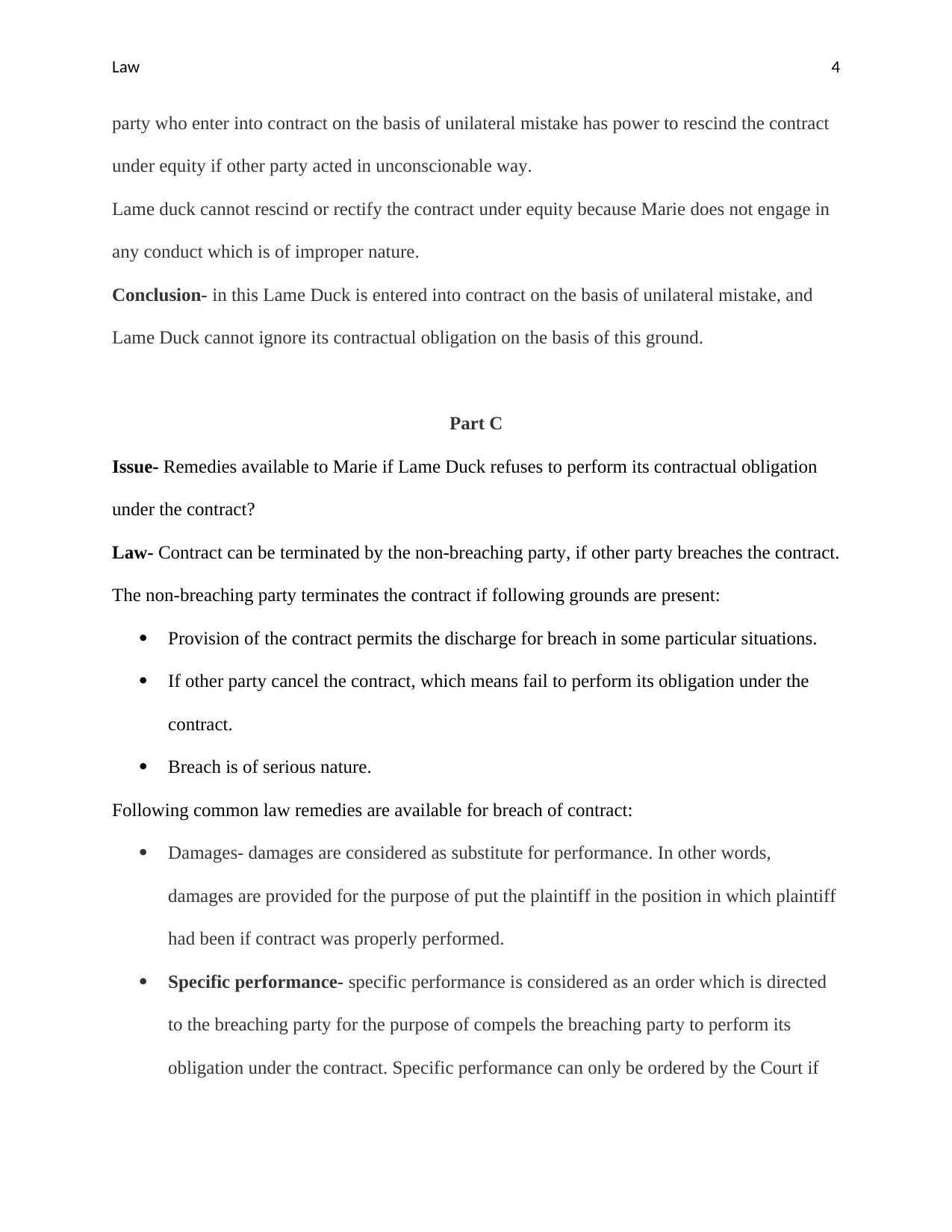
Law 4
party who enter into contract on the basis of unilateral mistake has power to rescind the contract
under equity if other party acted in unconscionable way.
Lame duck cannot rescind or rectify the contract under equity because Marie does not engage in
any conduct which is of improper nature.
Conclusion- in this Lame Duck is entered into contract on the basis of unilateral mistake, and
Lame Duck cannot ignore its contractual obligation on the basis of this ground.
Part C
Issue- Remedies available to Marie if Lame Duck refuses to perform its contractual obligation
under the contract?
Law- Contract can be terminated by the non-breaching party, if other party breaches the contract.
The non-breaching party terminates the contract if following grounds are present:
Provision of the contract permits the discharge for breach in some particular situations.
If other party cancel the contract, which means fail to perform its obligation under the
contract.
Breach is of serious nature.
Following common law remedies are available for breach of contract:
Damages- damages are considered as substitute for performance. In other words,
damages are provided for the purpose of put the plaintiff in the position in which plaintiff
had been if contract was properly performed.
Specific performance- specific performance is considered as an order which is directed
to the breaching party for the purpose of compels the breaching party to perform its
obligation under the contract. Specific performance can only be ordered by the Court if
party who enter into contract on the basis of unilateral mistake has power to rescind the contract
under equity if other party acted in unconscionable way.
Lame duck cannot rescind or rectify the contract under equity because Marie does not engage in
any conduct which is of improper nature.
Conclusion- in this Lame Duck is entered into contract on the basis of unilateral mistake, and
Lame Duck cannot ignore its contractual obligation on the basis of this ground.
Part C
Issue- Remedies available to Marie if Lame Duck refuses to perform its contractual obligation
under the contract?
Law- Contract can be terminated by the non-breaching party, if other party breaches the contract.
The non-breaching party terminates the contract if following grounds are present:
Provision of the contract permits the discharge for breach in some particular situations.
If other party cancel the contract, which means fail to perform its obligation under the
contract.
Breach is of serious nature.
Following common law remedies are available for breach of contract:
Damages- damages are considered as substitute for performance. In other words,
damages are provided for the purpose of put the plaintiff in the position in which plaintiff
had been if contract was properly performed.
Specific performance- specific performance is considered as an order which is directed
to the breaching party for the purpose of compels the breaching party to perform its
obligation under the contract. Specific performance can only be ordered by the Court if
Paraphrase This Document
Need a fresh take? Get an instant paraphrase of this document with our AI Paraphraser
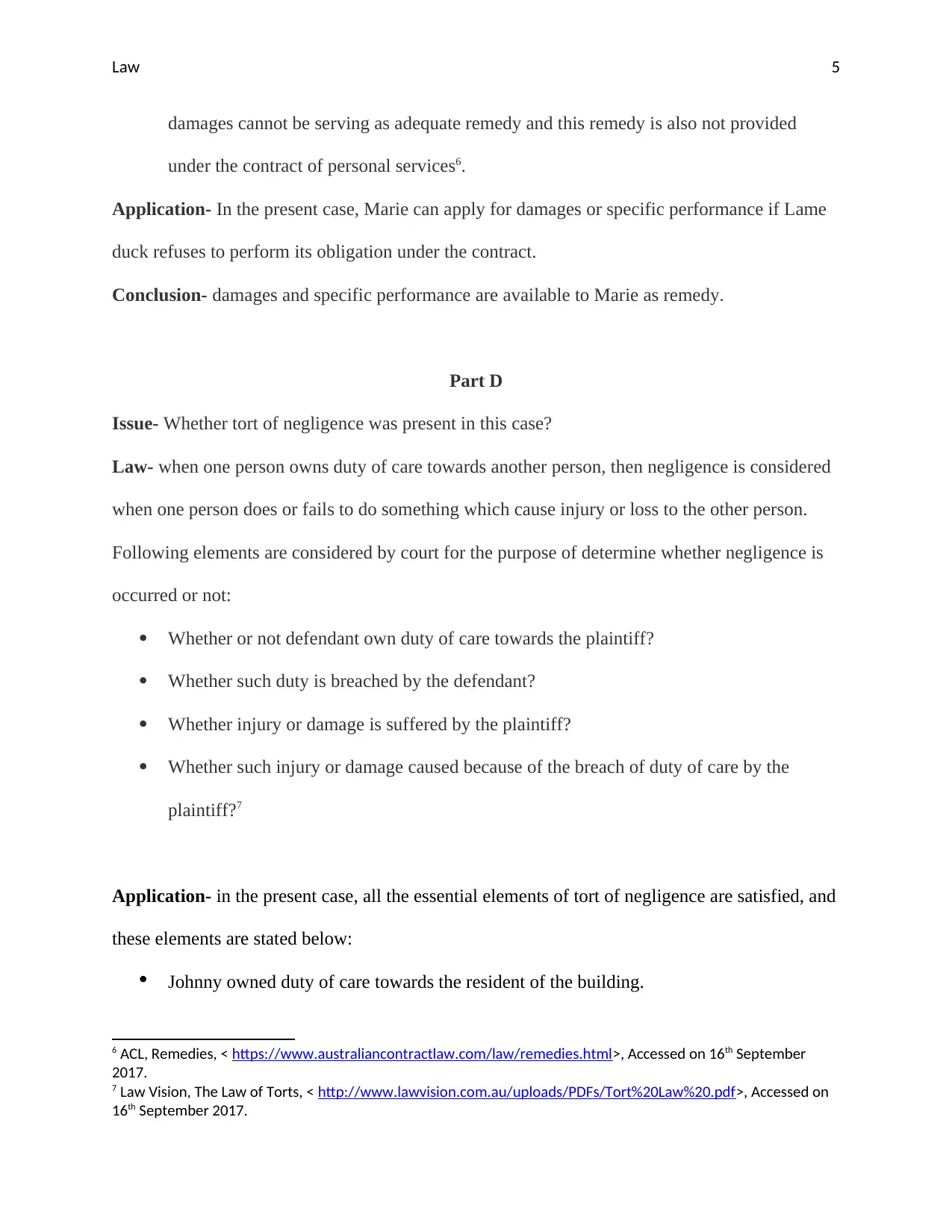
Law 5
damages cannot be serving as adequate remedy and this remedy is also not provided
under the contract of personal services6.
Application- In the present case, Marie can apply for damages or specific performance if Lame
duck refuses to perform its obligation under the contract.
Conclusion- damages and specific performance are available to Marie as remedy.
Part D
Issue- Whether tort of negligence was present in this case?
Law- when one person owns duty of care towards another person, then negligence is considered
when one person does or fails to do something which cause injury or loss to the other person.
Following elements are considered by court for the purpose of determine whether negligence is
occurred or not:
Whether or not defendant own duty of care towards the plaintiff?
Whether such duty is breached by the defendant?
Whether injury or damage is suffered by the plaintiff?
Whether such injury or damage caused because of the breach of duty of care by the
plaintiff?7
Application- in the present case, all the essential elements of tort of negligence are satisfied, and
these elements are stated below:
Johnny owned duty of care towards the resident of the building.
6 ACL, Remedies, < https://www.australiancontractlaw.com/law/remedies.html>, Accessed on 16th September
2017.
7 Law Vision, The Law of Torts, < http://www.lawvision.com.au/uploads/PDFs/Tort%20Law%20.pdf>, Accessed on
16th September 2017.
damages cannot be serving as adequate remedy and this remedy is also not provided
under the contract of personal services6.
Application- In the present case, Marie can apply for damages or specific performance if Lame
duck refuses to perform its obligation under the contract.
Conclusion- damages and specific performance are available to Marie as remedy.
Part D
Issue- Whether tort of negligence was present in this case?
Law- when one person owns duty of care towards another person, then negligence is considered
when one person does or fails to do something which cause injury or loss to the other person.
Following elements are considered by court for the purpose of determine whether negligence is
occurred or not:
Whether or not defendant own duty of care towards the plaintiff?
Whether such duty is breached by the defendant?
Whether injury or damage is suffered by the plaintiff?
Whether such injury or damage caused because of the breach of duty of care by the
plaintiff?7
Application- in the present case, all the essential elements of tort of negligence are satisfied, and
these elements are stated below:
Johnny owned duty of care towards the resident of the building.
6 ACL, Remedies, < https://www.australiancontractlaw.com/law/remedies.html>, Accessed on 16th September
2017.
7 Law Vision, The Law of Torts, < http://www.lawvision.com.au/uploads/PDFs/Tort%20Law%20.pdf>, Accessed on
16th September 2017.
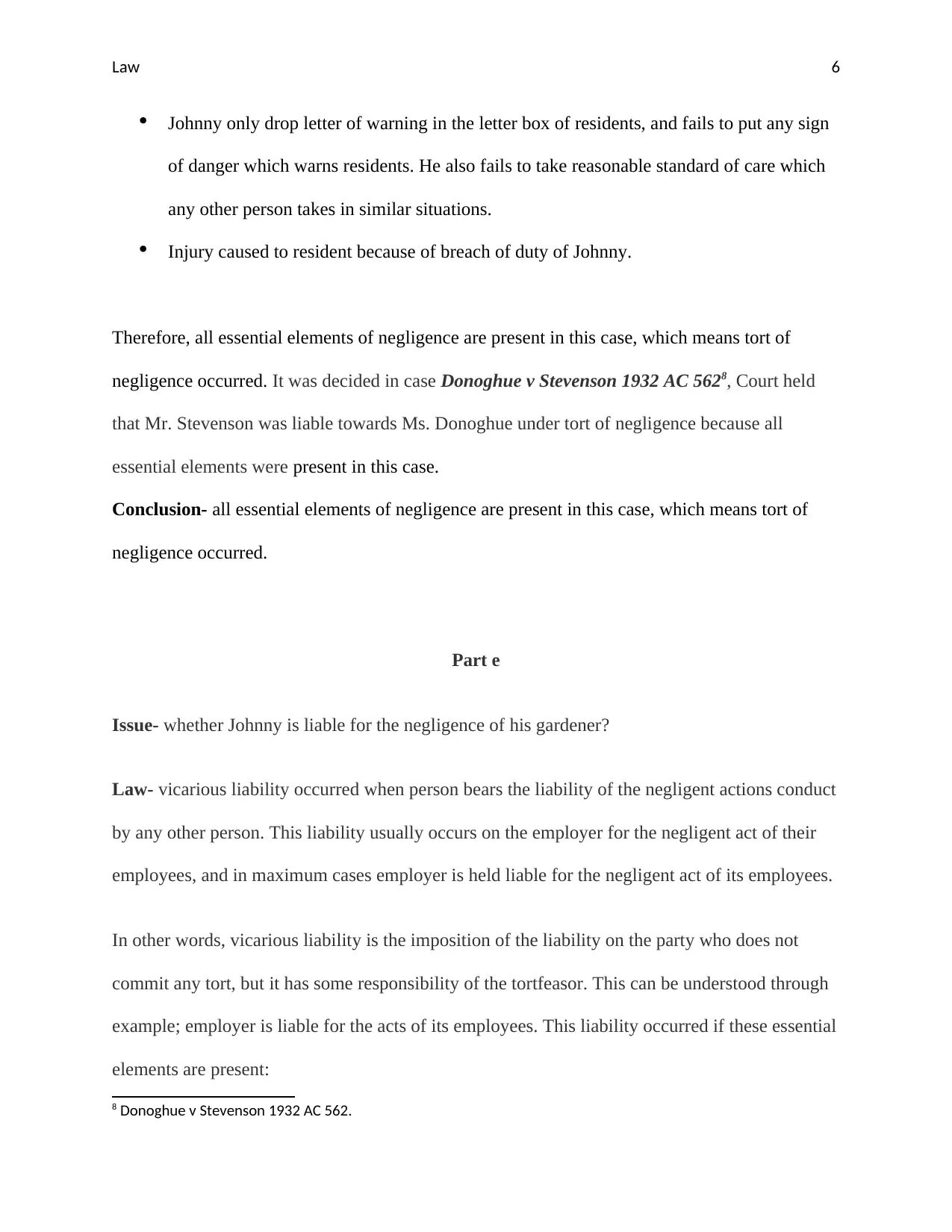
Law 6
Johnny only drop letter of warning in the letter box of residents, and fails to put any sign
of danger which warns residents. He also fails to take reasonable standard of care which
any other person takes in similar situations.
Injury caused to resident because of breach of duty of Johnny.
Therefore, all essential elements of negligence are present in this case, which means tort of
negligence occurred. It was decided in case Donoghue v Stevenson 1932 AC 5628, Court held
that Mr. Stevenson was liable towards Ms. Donoghue under tort of negligence because all
essential elements were present in this case.
Conclusion- all essential elements of negligence are present in this case, which means tort of
negligence occurred.
Part e
Issue- whether Johnny is liable for the negligence of his gardener?
Law- vicarious liability occurred when person bears the liability of the negligent actions conduct
by any other person. This liability usually occurs on the employer for the negligent act of their
employees, and in maximum cases employer is held liable for the negligent act of its employees.
In other words, vicarious liability is the imposition of the liability on the party who does not
commit any tort, but it has some responsibility of the tortfeasor. This can be understood through
example; employer is liable for the acts of its employees. This liability occurred if these essential
elements are present:
8 Donoghue v Stevenson 1932 AC 562.
Johnny only drop letter of warning in the letter box of residents, and fails to put any sign
of danger which warns residents. He also fails to take reasonable standard of care which
any other person takes in similar situations.
Injury caused to resident because of breach of duty of Johnny.
Therefore, all essential elements of negligence are present in this case, which means tort of
negligence occurred. It was decided in case Donoghue v Stevenson 1932 AC 5628, Court held
that Mr. Stevenson was liable towards Ms. Donoghue under tort of negligence because all
essential elements were present in this case.
Conclusion- all essential elements of negligence are present in this case, which means tort of
negligence occurred.
Part e
Issue- whether Johnny is liable for the negligence of his gardener?
Law- vicarious liability occurred when person bears the liability of the negligent actions conduct
by any other person. This liability usually occurs on the employer for the negligent act of their
employees, and in maximum cases employer is held liable for the negligent act of its employees.
In other words, vicarious liability is the imposition of the liability on the party who does not
commit any tort, but it has some responsibility of the tortfeasor. This can be understood through
example; employer is liable for the acts of its employees. This liability occurred if these essential
elements are present:
8 Donoghue v Stevenson 1932 AC 562.
⊘ This is a preview!⊘
Do you want full access?
Subscribe today to unlock all pages.

Trusted by 1+ million students worldwide
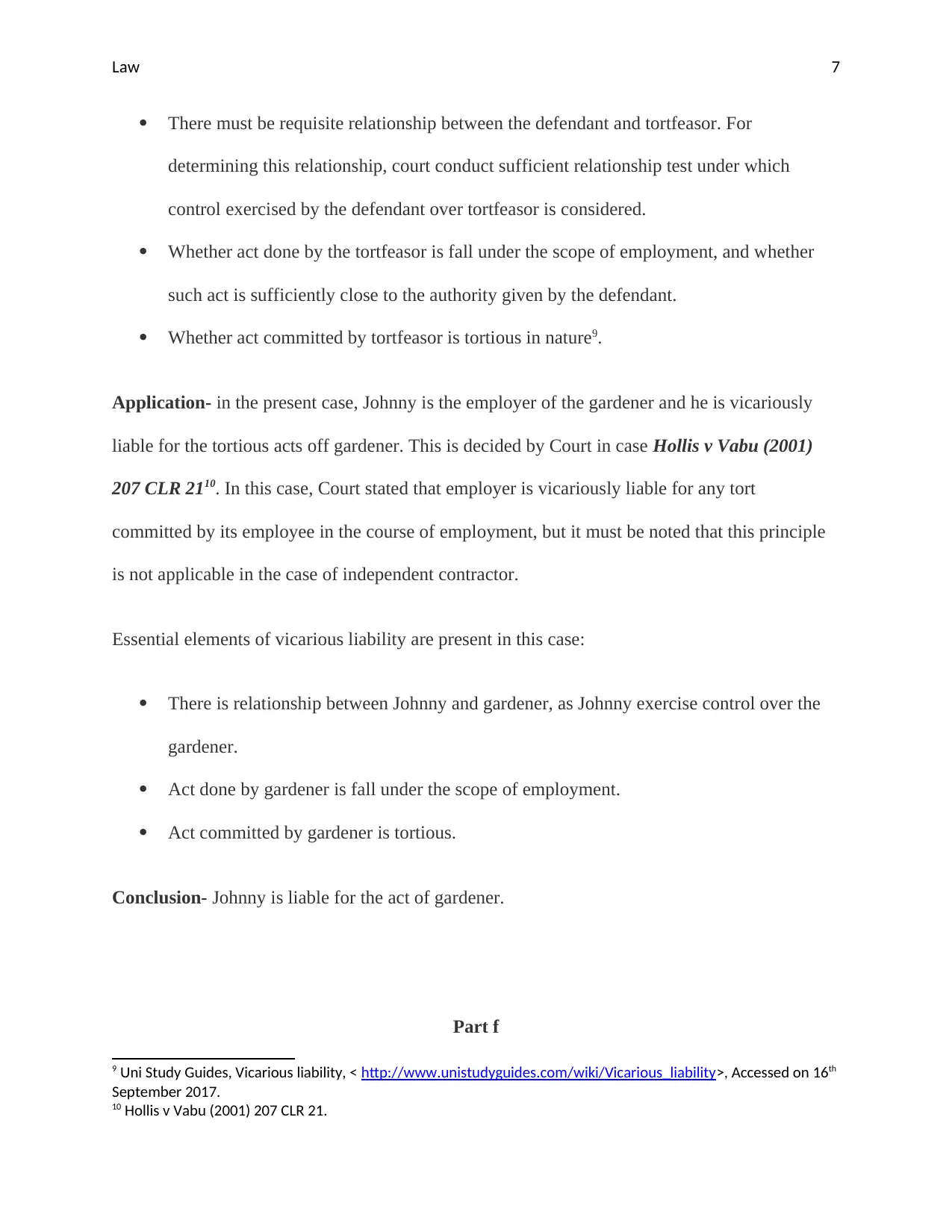
Law 7
There must be requisite relationship between the defendant and tortfeasor. For
determining this relationship, court conduct sufficient relationship test under which
control exercised by the defendant over tortfeasor is considered.
Whether act done by the tortfeasor is fall under the scope of employment, and whether
such act is sufficiently close to the authority given by the defendant.
Whether act committed by tortfeasor is tortious in nature9.
Application- in the present case, Johnny is the employer of the gardener and he is vicariously
liable for the tortious acts off gardener. This is decided by Court in case Hollis v Vabu (2001)
207 CLR 2110. In this case, Court stated that employer is vicariously liable for any tort
committed by its employee in the course of employment, but it must be noted that this principle
is not applicable in the case of independent contractor.
Essential elements of vicarious liability are present in this case:
There is relationship between Johnny and gardener, as Johnny exercise control over the
gardener.
Act done by gardener is fall under the scope of employment.
Act committed by gardener is tortious.
Conclusion- Johnny is liable for the act of gardener.
Part f
9 Uni Study Guides, Vicarious liability, < http://www.unistudyguides.com/wiki/Vicarious_liability>, Accessed on 16th
September 2017.
10 Hollis v Vabu (2001) 207 CLR 21.
There must be requisite relationship between the defendant and tortfeasor. For
determining this relationship, court conduct sufficient relationship test under which
control exercised by the defendant over tortfeasor is considered.
Whether act done by the tortfeasor is fall under the scope of employment, and whether
such act is sufficiently close to the authority given by the defendant.
Whether act committed by tortfeasor is tortious in nature9.
Application- in the present case, Johnny is the employer of the gardener and he is vicariously
liable for the tortious acts off gardener. This is decided by Court in case Hollis v Vabu (2001)
207 CLR 2110. In this case, Court stated that employer is vicariously liable for any tort
committed by its employee in the course of employment, but it must be noted that this principle
is not applicable in the case of independent contractor.
Essential elements of vicarious liability are present in this case:
There is relationship between Johnny and gardener, as Johnny exercise control over the
gardener.
Act done by gardener is fall under the scope of employment.
Act committed by gardener is tortious.
Conclusion- Johnny is liable for the act of gardener.
Part f
9 Uni Study Guides, Vicarious liability, < http://www.unistudyguides.com/wiki/Vicarious_liability>, Accessed on 16th
September 2017.
10 Hollis v Vabu (2001) 207 CLR 21.
Paraphrase This Document
Need a fresh take? Get an instant paraphrase of this document with our AI Paraphraser
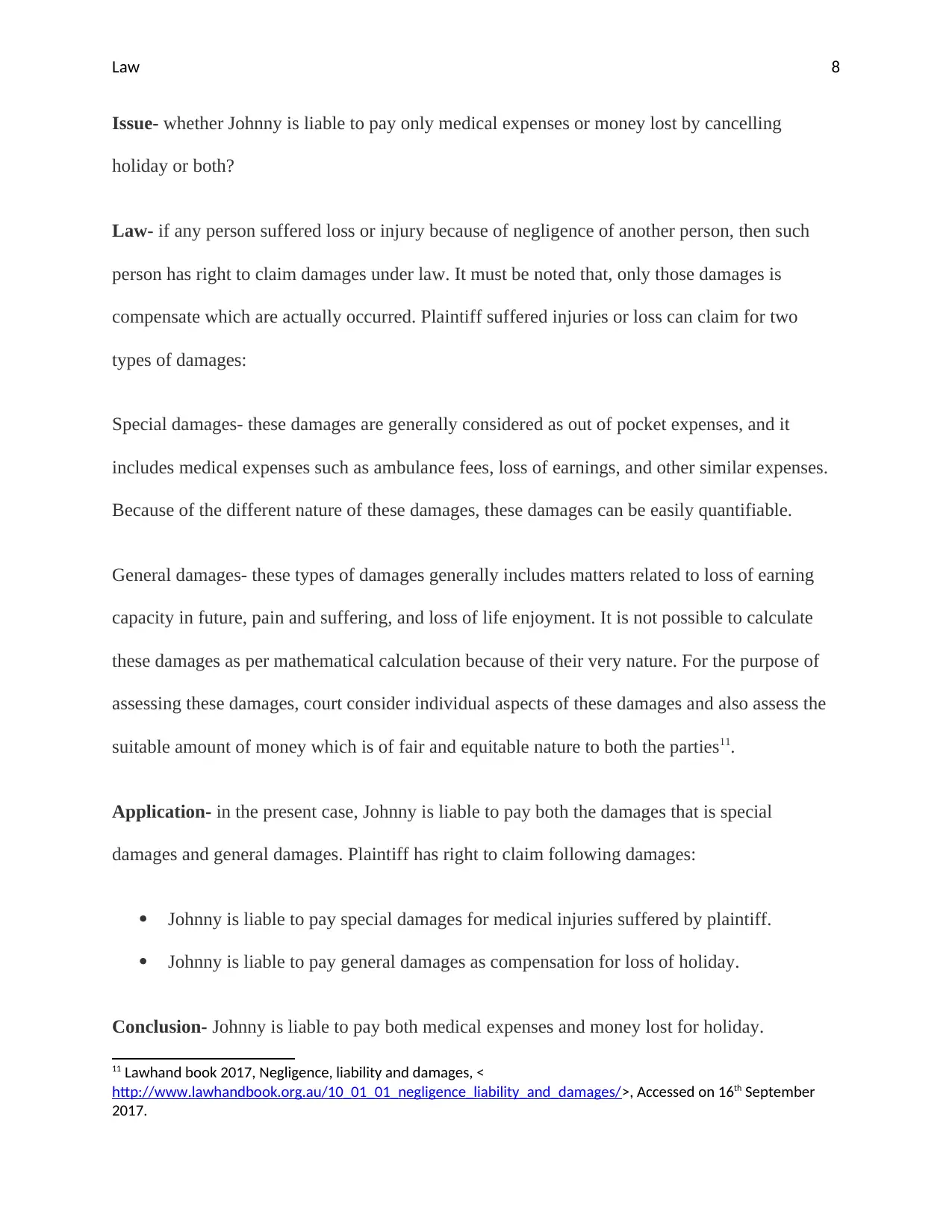
Law 8
Issue- whether Johnny is liable to pay only medical expenses or money lost by cancelling
holiday or both?
Law- if any person suffered loss or injury because of negligence of another person, then such
person has right to claim damages under law. It must be noted that, only those damages is
compensate which are actually occurred. Plaintiff suffered injuries or loss can claim for two
types of damages:
Special damages- these damages are generally considered as out of pocket expenses, and it
includes medical expenses such as ambulance fees, loss of earnings, and other similar expenses.
Because of the different nature of these damages, these damages can be easily quantifiable.
General damages- these types of damages generally includes matters related to loss of earning
capacity in future, pain and suffering, and loss of life enjoyment. It is not possible to calculate
these damages as per mathematical calculation because of their very nature. For the purpose of
assessing these damages, court consider individual aspects of these damages and also assess the
suitable amount of money which is of fair and equitable nature to both the parties11.
Application- in the present case, Johnny is liable to pay both the damages that is special
damages and general damages. Plaintiff has right to claim following damages:
Johnny is liable to pay special damages for medical injuries suffered by plaintiff.
Johnny is liable to pay general damages as compensation for loss of holiday.
Conclusion- Johnny is liable to pay both medical expenses and money lost for holiday.
11 Lawhand book 2017, Negligence, liability and damages, <
http://www.lawhandbook.org.au/10_01_01_negligence_liability_and_damages/>, Accessed on 16th September
2017.
Issue- whether Johnny is liable to pay only medical expenses or money lost by cancelling
holiday or both?
Law- if any person suffered loss or injury because of negligence of another person, then such
person has right to claim damages under law. It must be noted that, only those damages is
compensate which are actually occurred. Plaintiff suffered injuries or loss can claim for two
types of damages:
Special damages- these damages are generally considered as out of pocket expenses, and it
includes medical expenses such as ambulance fees, loss of earnings, and other similar expenses.
Because of the different nature of these damages, these damages can be easily quantifiable.
General damages- these types of damages generally includes matters related to loss of earning
capacity in future, pain and suffering, and loss of life enjoyment. It is not possible to calculate
these damages as per mathematical calculation because of their very nature. For the purpose of
assessing these damages, court consider individual aspects of these damages and also assess the
suitable amount of money which is of fair and equitable nature to both the parties11.
Application- in the present case, Johnny is liable to pay both the damages that is special
damages and general damages. Plaintiff has right to claim following damages:
Johnny is liable to pay special damages for medical injuries suffered by plaintiff.
Johnny is liable to pay general damages as compensation for loss of holiday.
Conclusion- Johnny is liable to pay both medical expenses and money lost for holiday.
11 Lawhand book 2017, Negligence, liability and damages, <
http://www.lawhandbook.org.au/10_01_01_negligence_liability_and_damages/>, Accessed on 16th September
2017.

Law 9
⊘ This is a preview!⊘
Do you want full access?
Subscribe today to unlock all pages.

Trusted by 1+ million students worldwide
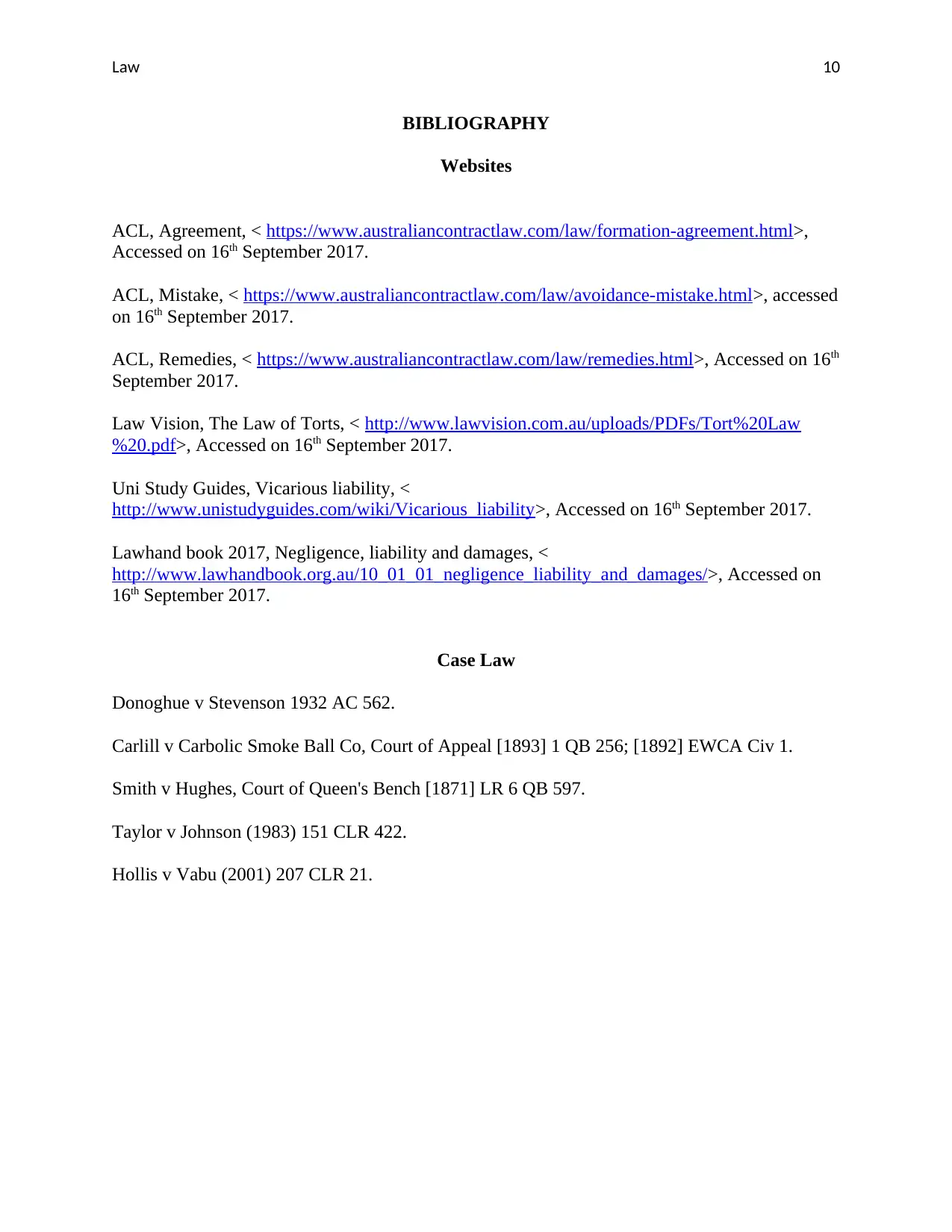
Law 10
BIBLIOGRAPHY
Websites
ACL, Agreement, < https://www.australiancontractlaw.com/law/formation-agreement.html>,
Accessed on 16th September 2017.
ACL, Mistake, < https://www.australiancontractlaw.com/law/avoidance-mistake.html>, accessed
on 16th September 2017.
ACL, Remedies, < https://www.australiancontractlaw.com/law/remedies.html>, Accessed on 16th
September 2017.
Law Vision, The Law of Torts, < http://www.lawvision.com.au/uploads/PDFs/Tort%20Law
%20.pdf>, Accessed on 16th September 2017.
Uni Study Guides, Vicarious liability, <
http://www.unistudyguides.com/wiki/Vicarious_liability>, Accessed on 16th September 2017.
Lawhand book 2017, Negligence, liability and damages, <
http://www.lawhandbook.org.au/10_01_01_negligence_liability_and_damages/>, Accessed on
16th September 2017.
Case Law
Donoghue v Stevenson 1932 AC 562.
Carlill v Carbolic Smoke Ball Co, Court of Appeal [1893] 1 QB 256; [1892] EWCA Civ 1.
Smith v Hughes, Court of Queen's Bench [1871] LR 6 QB 597.
Taylor v Johnson (1983) 151 CLR 422.
Hollis v Vabu (2001) 207 CLR 21.
BIBLIOGRAPHY
Websites
ACL, Agreement, < https://www.australiancontractlaw.com/law/formation-agreement.html>,
Accessed on 16th September 2017.
ACL, Mistake, < https://www.australiancontractlaw.com/law/avoidance-mistake.html>, accessed
on 16th September 2017.
ACL, Remedies, < https://www.australiancontractlaw.com/law/remedies.html>, Accessed on 16th
September 2017.
Law Vision, The Law of Torts, < http://www.lawvision.com.au/uploads/PDFs/Tort%20Law
%20.pdf>, Accessed on 16th September 2017.
Uni Study Guides, Vicarious liability, <
http://www.unistudyguides.com/wiki/Vicarious_liability>, Accessed on 16th September 2017.
Lawhand book 2017, Negligence, liability and damages, <
http://www.lawhandbook.org.au/10_01_01_negligence_liability_and_damages/>, Accessed on
16th September 2017.
Case Law
Donoghue v Stevenson 1932 AC 562.
Carlill v Carbolic Smoke Ball Co, Court of Appeal [1893] 1 QB 256; [1892] EWCA Civ 1.
Smith v Hughes, Court of Queen's Bench [1871] LR 6 QB 597.
Taylor v Johnson (1983) 151 CLR 422.
Hollis v Vabu (2001) 207 CLR 21.
1 out of 10
Related Documents
Your All-in-One AI-Powered Toolkit for Academic Success.
+13062052269
info@desklib.com
Available 24*7 on WhatsApp / Email
![[object Object]](/_next/static/media/star-bottom.7253800d.svg)
Unlock your academic potential
Copyright © 2020–2026 A2Z Services. All Rights Reserved. Developed and managed by ZUCOL.





